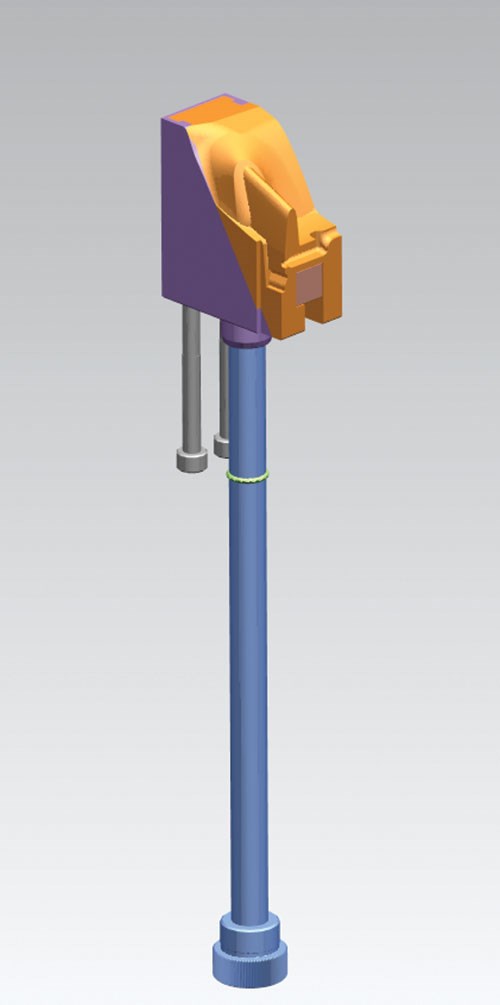Angles Stop Negative Areas from Undercutting the Injection Process
The new vertical lifter design provides a range of advantages during mold construction: space savings, easier machining and simplicity of assembly.
For one injection molder and toolmaker it was time to examine a completely new approach to one of the common problems that arises during the design stage of a plastic injection mold: undercut release.
Maier S. Coop of Guernica, Spain realized the more complex injection molded parts become, the more difficult it can be to remove them from the tool. In many plastic parts, negative or undercut areas need to be released in order to allow the part to be ejected. Sometimes it is not possible to do this by means of a conventional external slide core, so it is necessary to use an angled device actuated by the movement of the ejector plate that carries the ejector pins.
Seeking a Nontraditional Solution
The traditional solution to this particular problem has always been to use lifters or other similarly angled mechanisms that convert the ejector plate movement into lateral part release, which allows the undercut to be freed.
However, this has always required difficult angled machining operations for the mold plates and inserts. In the case presented here, the molded products in question are chrome-plated bars on a car’s front grill—namely, the Audi Q3 S-Type. The problem was threefold: (1) the large angle of the undercuts; (2) the large number of undercuts per bar; and, (3) the high number of mold cavities.
Once Maier discovered the undercuts could be released by using DH series vertical lifters from Cumsa, the company contacted the supplier and learned that a number of modifications would be required. Some of them would be relatively easy (such as an increase in the length of the pin), but others would not be (such as the release of undercut angles of up to 28 degrees from an ejection stroke of 13 mm).
Cumsa helped by modifying its lifters quickly enough to allow Maier to develop two different solutions for the same problem. Maier manufactured two different molds—one with traditional-style inclined lifters and the other with Cumsa’s devices.
Time and Cost Savings, Processing Improvements
According to Cumsa, its system provides a range of advantages during mold construction, which Maier believes includes space savings, easier machining and simplicity of assembly.
In addition, the system is expected to also reduce maintenance requirements for the entire life of the mold. According to Maier, the machining process has been simplified and plenty of space has been freed up in the ejector plates, making possible the addition of many more regular ejector pins, should they be required.
With this new design, the required ejector stroke is reduced, which creates faster cycle times, hence cost savings, according to Maier. This can also be added to the time savings for mold construction, which is quoted at 40 percent thanks to the ability to machine less and more easily.
This system also allows two units to be assembled very closely together, which in the case of most conventional lifters is not possible. According to Cumsa, it also is developing a completely new range of lifters based on this concept, which will target large molds with deeper release movements.
Related Content
Moldmakers Deserve a Total Production Solution
Stability, spindle speed and software are essential consideration for your moldmaking machine tool.
Read MoreMachining Center Spindles: What You Need to Know
Why and how to research spindle technology before purchasing a machining center.
Read MoreAdvantages and Disadvantages of Copper and Graphite Electrodes
Both copper and graphite provide approximately the same end result, so it is important for a shop to consider the advantages and disadvantages of each material in order to discover what would work best in their shop floor environment.
Read More6 Ways to Optimize High-Feed Milling
High-feed milling can significantly outweigh potential reliability challenges. Consider these six strategies in order to make high-feed milling successful for your business.
Read MoreRead Next
Calculating the Benefits of Standard Slides
Design flexibility, time savings, engineering support and design assistance are great benefits to moldmakers from standard components.
Read MoreHow to Use Strategic Planning Tools, Data to Manage the Human Side of Business
Q&A with Marion Wells, MMT EAB member and founder of Human Asset Management.
Read MoreReasons to Use Fiber Lasers for Mold Cleaning
Fiber lasers offer a simplicity, speed, control and portability, minimizing mold cleaning risks.
Read More













.jpg;maxWidth=300;quality=90)











